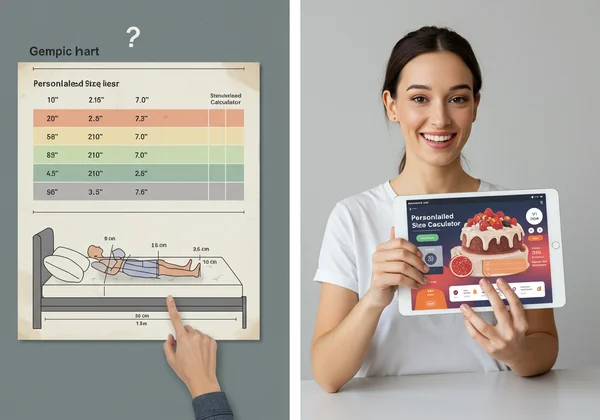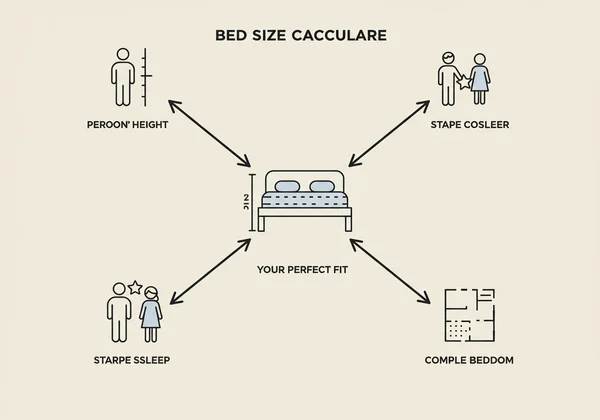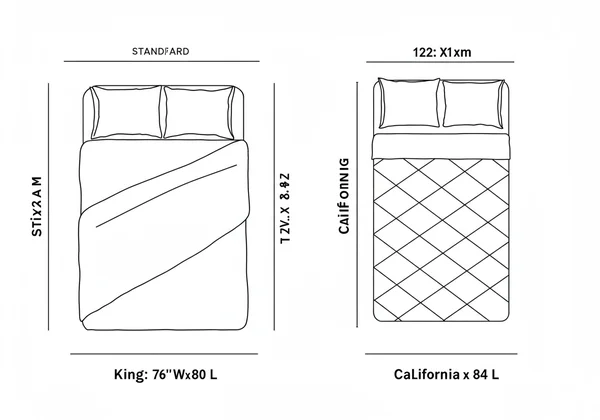What Size Bed Should I Get? The Science Behind Our Calculator
Tired of staring at generic bed size charts that feel completely impersonal? Choosing a new mattress is a significant decision for your sleep quality and daily energy, yet most advice boils down to a simple list of dimensions. But you are more than just a number on a chart. What size bed should I get for my unique needs? This is the real question, and it deserves a scientific, personalized answer. We’ve moved beyond one-size-fits-all advice by developing an intelligent tool that analyzes your individual data.
Forget the guesswork. We've engineered a system that considers your body, your room, and your sleep habits to provide a recommendation you can trust. It’s time to discover the data-backed logic we use to generate a truly personal fit. To see the science in action, you can try our free tool today and get an instant recommendation.
Beyond the Chart: Choosing the Right Mattress Size
For decades, the process of choosing a mattress size has been surprisingly unsophisticated. You look at a chart, maybe measure your room, and make a guess. This approach often leads to buyer's remorse, whether it's a bed that's too cramped for comfort or one that overwhelms a small bedroom. We believe a better method is not only possible but necessary. The key is to shift the focus from the mattress's dimensions to the user's dimensions—in every sense of the word.
Why Standard Dimensions Don't Tell the Whole Story
A Queen bed is 60 inches wide and 80 inches long. While this fact is accurate, it's not inherently useful on its own. For a petite individual who sleeps curled up, a Queen might feel palatial. For a tall person who sprawls out, or a couple sharing the bed, that same Queen can feel restrictive, directly impacting sleep quality. Standard dimensions fail to account for the dynamic nature of sleep and the unique physical characteristics of the sleeper. This information gap is what our intelligent approach is designed to fill, ensuring you find the right fit for your body.
Introducing a Data-Driven Approach to Comfort
To provide a truly useful recommendation, we need more than just static measurements. We need dynamic data. Our bed size calculator was built on a simple premise: the perfect bed size is a function of multiple personal variables. It’s an algorithm for comfort. By inputting key details about your life and sleep, you allow our system to run a personalized analysis that static charts simply cannot perform. This method respects your need for personal space and acknowledges that the ideal bed is one that adapts to you, not the other way around.

The Logic Behind Our Bed Size Calculator
So, what is the logic that powers our recommendations? It's not a secret at all. It's a transparent, logical process that weighs several key factors to determine your optimal mattress size. Each piece of information you provide is a critical variable in the equation. Let's break down exactly what our tool analyzes and why each component is so important for an accurate result.

How Height and Weight Impact Your Bed Size Choice
Your physical frame is the most fundamental starting point. For taller individuals (over 6'2" or 188 cm), standard 80-inch long beds like the Queen can leave your feet dangling. Our calculator immediately flags this and prioritizes longer options like the Twin XL or California King. Similarly, body weight influences the need for surface area. A wider, more robust surface provides better support and prevents the feeling of "rolling off" the edge, ensuring the mattress dimensions are sufficient for both comfort and structural longevity.
Why Your Preferred Sleep Position Matters
Do you sleep like a soldier, straight on your back? Or do you spread out like a starfish? Your dominant sleep position has a massive impact on the amount of space you require. Side sleepers and fetal-position sleepers use less width, while back and stomach sleepers who extend their limbs need significantly more room. Our algorithm considers these sleep habits to ensure you won't feel confined, even if you toss and turn throughout the night.
Calculating Space for Couples and Partners
Choosing a bed for two adds another layer of complexity. Our tool doesn't just double the space; it analyzes the needs of both individuals. It considers whether you're easily disturbed by a partner's movements, a factor known as motion sensitivity. For couples who value their own sleeping zones or are sensitive to disturbances, the calculator will heavily favor wider options like a King over a Queen. This focus on couples' comfort is critical for ensuring both partners get a restful night's sleep together. Ready to find a bed that fits both of you? Find your perfect fit.
Matching Your Mattress to Your Bedroom Dimensions
A perfect bed in the wrong room is still the wrong bed. The final, critical piece of the puzzle is your bedroom's size. A massive Alaskan King bed might sound luxurious, but if it leaves no room for nightstands or walking paths, it will create a cluttered and stressful environment. Our system analyzes your bedroom layout, recommending sizes that leave adequate space (typically 24-30 inches) around the bed for movement and other furniture. This ensures your new bed complements your space instead of consuming it.
A Look at Our Bed Size Recommendations in Action
Theory is one thing, but real-world application is where our tool proves its value. Let's look at two common scenarios where a data-driven approach provides a far better solution than a simple chart ever could.
Case Study: Finding the Best Bed for a Tall Sleeper
Meet Alex, who is 6'5". For years, Alex slept diagonally on a Queen bed, his feet constantly hanging off the edge. Frustrated, he considered a King bed, assuming bigger was better. However, after using our tool and inputting his height, sleeping style (back sleeper), and bedroom size, the recommendation was clear: a California King. While a King is wider, a Cal King is 4 inches longer. Our algorithm identified his primary pain point—length—and provided the perfect solution that Alex hadn't even considered. Our smart tool solved a problem he had for years in under a minute.
Case Study: Solving the Space Dilemma for Couples
Consider Maria and Ben, a couple upgrading from a Full bed. They both have different sleep styles; Maria is a combination sleeper who moves a lot, while Ben is a light sleeper easily disturbed by her movement. They thought a Queen would be a sufficient upgrade. However, after entering their data, including their high sensitivity to partner movement, our tool recommended a standard King. It explained that the King's 16 extra inches of width would give them each the equivalent of a Twin XL bed to themselves, creating distinct sleep zones and dramatically reducing motion transfer. This insight helped them invest in a size that truly supported their relationship and sleep quality.

Choosing the right bed size shouldn't be a game of chance. It's a science of personal fit, and you deserve a tool that treats it as such. By analyzing your height, weight, sleep position, partner needs, and room dimensions, our calculator removes the guesswork and empowers you to make a confident, informed decision. You no longer have to wonder if a Queen is big enough or if a King will fit your room.
You can get a clear, personalized, and data-driven answer right now. Stop relying on impersonal charts and discover the size that was truly made for you. Ready to find your perfect match? Get your recommendation now!
Frequently Asked Questions About Choosing a Bed Size
What size bed should I get?
This is the most common question, and the answer is always: it depends on you. The best bed size depends on your height, weight, whether you sleep alone or with a partner, your preferred sleep position, and the size of your bedroom. Instead of guessing based on a generic bed sizes chart, the most reliable way to answer this is to use a personalized tool that weighs all these factors.
Is a full bed big enough for two people?
A Full bed (also known as a Double) is 54 inches wide, which gives each person only 27 inches of space—the same width as a crib. While it can work for some couples, especially for shorter durations, most find it too cramped for comfortable, long-term sleep. If you are a couple considering a Full size, we highly recommend using our calculator to see if a Queen might be a more suitable fit without overwhelming your room.
What is the real difference between a King and California King?
Many people think a California King is bigger than a King, but that's not exactly true. A standard King is wider and shorter (76"W x 80"L), making it ideal for couples who want maximum personal space. A California King is narrower and longer (72"W x 84"L), making it the perfect choice for taller individuals who need extra legroom. The right choice depends on whether your priority is width or length, a question our tool is designed to help you answer. Why not discover your results and see which one is right for you?
